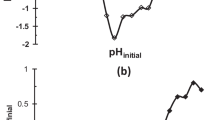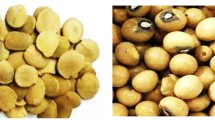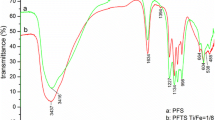Abstract
This work focuses on the adsorptive study of paint effluent coagulation using snail shell coagulant (SSC), in which samples were subjected to physiochemical and instrumental analyses [Fourier transform infrared (FTIR), differential scanning calorimetry/thermo gravimetric analysis (DSC/TGA), scanning electron micrograph (SEM), X-ray diffraction (XRD)]. Nephelometric jar test was also employed and the data generated were subjected to adsorptive kinetic, equilibrium and thermodynamics analyses. 42 % protein was recorded for the snail shell. SEM images and FTIR spectra indicated significant porosity and ammine presence in the SSC. DSC/TGA and XRD indicated samples of high thermal stability and organized crystalline structure, respectively. The data correlated best with Langmuir isotherm with linear regression coefficient (R 2) values >0.9 over the temperatures investigated. Pseudo-second-order kinetic model best described the process at \(K_{2} < 0.05\) (g/mg/min) and R 2 values >0.99. The thermodynamics parameter (\({\Delta G}\), \({\Delta H}\) and \({\Delta S}\)) shows that the process was feasible and spontaneous. The intra-particle diffusion was found to be the rate-limiting step. It could be concluded that while SSC achieved 92 % turbidity removal, the adsorptive component of the process was significant.
Similar content being viewed by others
Abbreviations
- SS:
-
Snail shell
- SSC:
-
Snail shell coagulant
- PE:
-
Paint effluent
- SSCPE:
-
Snail shell onto paint effluent
- TDSP:
-
Total dissolved and suspended particles.
- \({\Delta G}\) :
-
Change in Gibb’s free energy
- \({\Delta H}\) :
-
Enthalpy change
- \({\Delta S}\) :
-
Entropy change
References
Woodard F: Industrial Waste Treatment Handbook. Butterworth–Heinemann, USA (2001)
Fernandez-Kim, S.: Physiochemical and functional properties of Crawfish Chitosan as Affected by Different Processing Protocols: M.Sc thesis, Dept. of Food Science; Louisiana State University, USA, pp. 1–3, 32–40 (2004)
Edzwald, J.K.: Coagulation- sedimentation filtration process for removing organic substances in drinking and waste water, pp. 26–27. Noyes Data Corporation, Park Bridge, New Jersey (1987)
Vijaya, K.G.: Equilibrium and kinetic modeling on the removal of malachite green from aqueous solution using barytes. Anna University, India (2010)
Subramanyan, V.; Jothianathan, L.: Process condition and kinetics for the removal of copper from water by electrocoagulation. Environ. Eng. Sci. 29(7), 563–572 (2012). doi:10.1089/ees.2010.0429
Kamaraj R., Davidson D.J., Sozhan G., Vasudevan S.: Adsorption of herbicide 2-(2,4-dichlorophenoxy) propanoic acid by electrochemically generated aluminum hydroxide as alternative to chemical dosing. RSC Adv. 5, 39799–39809 (2015)
Kamaraj R., Vasudevan S.: Evaluation of electrocoagulation process for the removal of strontium and cesium from aqueous solution. Chem. Eng. Res. Design 93, 522–530 (2015)
Kamaraj R., Vasudevan S.: Decontamination of selenate from aqueous solution by oxidized multi-walled carbon nanotubes. Powder Technol. 274, 268–275 (2015)
Menkiti M.C., Igbokwe P.K., Ugodulunwa X.O., Onukwuli D.O.: Rapid coagulation/flocculation kinetics of coal effluents with high organic content using blended and unblended chitin derived coagulants (CSC). Res. J. Appl. Sci. 3(4), 317–323 (2008)
Jatto E.O., Aisa I.O., Egbon E.E., Otutu J.O., Chukwuedo M.E., Ewansiha C.J.: Treatment of wastewater from food industry using snail shell. Acad. Arena 2(1), 32–36 (2010)
Bezerra, M.; Arruda, M.; Ferreira, C.: Cloud point extraction as a procedure of separation and pre-concentration for metal determination using spectroanalytical techniques: a review. Appl. Spectrosc. Rev. 40(4), 269–299 (2005)
Igwe J.C., Abia A.A.: A bio-separation process for removing heavy metals from waste water using bio-sorbents. Afr. J. Bio-Technol. 5(12), 1167–1179 (2006)
Menkiti, M.C.; Ejikeme, P.M.; Aneke, M.C.; Onukwuli, O.D.; Menkiti, N.U.: Adsorptive treatment of brewery waste water using activated carbon prepared from Afzelia africana wood sawdust. J. Chin. Adv. Mater. Soc. 3(3), 231–255 (2015). doi:10.1080/22243682.2015.1017607
Clesceri, L.S.; Greenberg, A.E.; Eaton, A.D.: Standard Methods for the Examination of Water and Waste Water, 20th edn. APHA, USA (1999)
Ortega R.E.: Characterization and processing relevance of food particulate materials. Part Sys. Character. 29, 192–203 (2012)
Black C.A.: Methods of Soil Analysis: Part I Physical and Mineralogical Properties. American Society of Agronomy, Madison, Wisconsin (1965)
AWWA American Water Works Association, Standard Methods for the Examination of Water (2005)
Sushanta D., Uday C.G.: J. Chem. Thermodynamics 40, 67–77 (2008)
Menkiti M.C., Aneke M.C., Ejikeme P.M., Onukwuli O.D., Menkiti N.U.: Adsorptive treatment of brewery effluent using activated Chrysophyllum albidum seed shell carbon. SpringerPlus 3, 213 (2014)
Brady J.B., Boardman S.J.: introducing mineralogy students to x-ray diffraction through optical diffraction experiment using lasers. J.Geol. Educ. 43(5), 471–476 (1995)
Yuh-Shan H.: Review of second-order models for adsorption systems. J. Hazard. Mater. B 136, 681–689 (2006)
Das B., Mondal N.K.: Univ. J. Environ. Res. Technol. 1(4), 515–530 (2011)
Maria Luisa S.: J. Food Eng. 105, 1–27 (2011)
Jothinathan L., Subramanyan V.: Graphene-a promising material for removal of perchlorate (ClO\({_{4}^{-})}\) from water. Environ. Sci. Pollut. Res. 20(8), 5114–5124 (2013)
Author information
Authors and Affiliations
Corresponding author
Rights and permissions
About this article
Cite this article
Menkiti, M.C., Ejimofor, M.I., Ezemagu, I.G. et al. Turbid-Metric Approach on the Study of Adsorptive Component of Paint Effluent Coagulation Using Snail Shell Extract. Arab J Sci Eng 41, 2527–2543 (2016). https://doi.org/10.1007/s13369-015-2013-2
Received:
Accepted:
Published:
Issue Date:
DOI: https://doi.org/10.1007/s13369-015-2013-2




